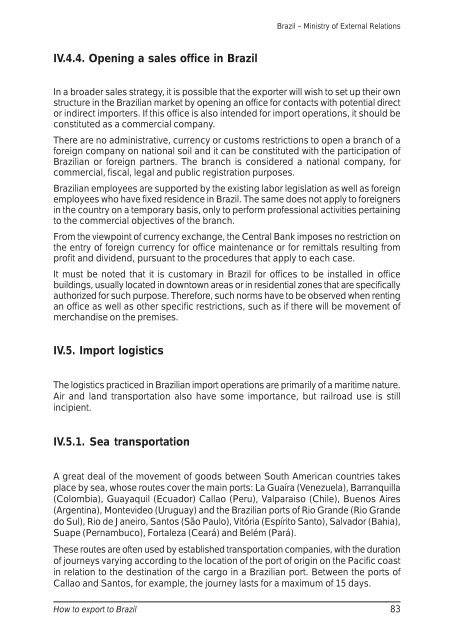How to Export to Brazil - Sprint Lazio
How to Export to Brazil - Sprint Lazio
How to Export to Brazil - Sprint Lazio
You also want an ePaper? Increase the reach of your titles
YUMPU automatically turns print PDFs into web optimized ePapers that Google loves.
IV.4.4. Opening a sales office in <strong>Brazil</strong><br />
<strong>Brazil</strong> – Ministry of External Relations<br />
In a broader sales strategy, it is possible that the exporter will wish <strong>to</strong> set up their own<br />
structure in the <strong>Brazil</strong>ian market by opening an office for contacts with potential direct<br />
or indirect importers. If this office is also intended for import operations, it should be<br />
constituted as a commercial company.<br />
There are no administrative, currency or cus<strong>to</strong>ms restrictions <strong>to</strong> open a branch of a<br />
foreign company on national soil and it can be constituted with the participation of<br />
<strong>Brazil</strong>ian or foreign partners. The branch is considered a national company, for<br />
commercial, fiscal, legal and public registration purposes.<br />
<strong>Brazil</strong>ian employees are supported by the existing labor legislation as well as foreign<br />
employees who have fixed residence in <strong>Brazil</strong>. The same does not apply <strong>to</strong> foreigners<br />
in the country on a temporary basis, only <strong>to</strong> perform professional activities pertaining<br />
<strong>to</strong> the commercial objectives of the branch.<br />
From the viewpoint of currency exchange, the Central Bank imposes no restriction on<br />
the entry of foreign currency for office maintenance or for remittals resulting from<br />
profit and dividend, pursuant <strong>to</strong> the procedures that apply <strong>to</strong> each case.<br />
It must be noted that it is cus<strong>to</strong>mary in <strong>Brazil</strong> for offices <strong>to</strong> be installed in office<br />
buildings, usually located in down<strong>to</strong>wn areas or in residential zones that are specifically<br />
authorized for such purpose. Therefore, such norms have <strong>to</strong> be observed when renting<br />
an office as well as other specific restrictions, such as if there will be movement of<br />
merchandise on the premises.<br />
IV.5. Import logistics<br />
The logistics practiced in <strong>Brazil</strong>ian import operations are primarily of a maritime nature.<br />
Air and land transportation also have some importance, but railroad use is still<br />
incipient.<br />
IV.5.1. Sea transportation<br />
A great deal of the movement of goods between South American countries takes<br />
place by sea, whose routes cover the main ports: La Guaíra (Venezuela), Barranquilla<br />
(Colombia), Guayaquil (Ecuador) Callao (Peru), Valparaiso (Chile), Buenos Aires<br />
(Argentina), Montevideo (Uruguay) and the <strong>Brazil</strong>ian ports of Rio Grande (Rio Grande<br />
do Sul), Rio de Janeiro, San<strong>to</strong>s (São Paulo), Vitória (Espíri<strong>to</strong> San<strong>to</strong>), Salvador (Bahia),<br />
Suape (Pernambuco), Fortaleza (Ceará) and Belém (Pará).<br />
These routes are often used by established transportation companies, with the duration<br />
of journeys varying according <strong>to</strong> the location of the port of origin on the Pacific coast<br />
in relation <strong>to</strong> the destination of the cargo in a <strong>Brazil</strong>ian port. Between the ports of<br />
Callao and San<strong>to</strong>s, for example, the journey lasts for a maximum of 15 days.<br />
<strong>How</strong> <strong>to</strong> export <strong>to</strong> <strong>Brazil</strong> 83


